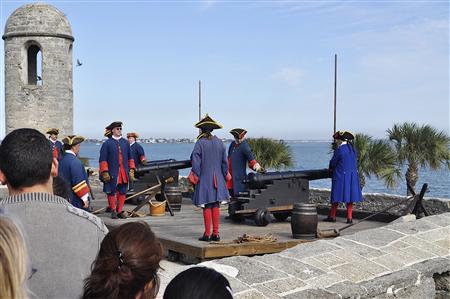
By Amy Wimmer Schwarb
Spanish explorer Ponce de Leon was only 4-foot, 11-inches tall, a trolley tour operator told his passengers as they rolled down a picturesque street in St. Augustine lined with moss-draped live oak trees.
But the Timucuan Indians he encountered when he set foot in Florida towered over him, standing 7 feet tall, the tour guide said.
Turning into the Fountain of Youth Archaeological Park, he noted: No wonder the explorer thought these tall, robust natives were drinking enchanted water.
This week Florida celebrated the 500th anniversary of the day when Ponce de Leon stepped onto the shores of what he thought was a large island and called the land "La Florida."
But the modern-day state of Florida built on the lure
of sunshine and myth of eternal youth is still grappling with how to
tell its first city's story — a rich history of centuries-old
multiculturalism, yet distorted by useful falsehoods aimed at
entertaining tourists who are important to its economy.
Take that trolley
tour, for instance. Ponce de Leon wasn't especially short, the natives
weren't especially tall, and the water at St. Augustine's Fountain of Youth
didn't offer eternal youth. In fact, not only did Ponce de Leon never
discover a Fountain of Youth, he wasn't even looking for one, historians
said.
"Ponce de Leon has
been said to be anywhere from 2 1/2 feet tall to 6 1/2 feet tall. The
Timucuan Indians were 7 or 8 feet tall, like they were out of a
space-age film or something," said J. Michael Francis, a history professor at the University of South Florida St. Petersburg who specializes in Spanish colonial Florida history.
Even that first moment, when Ponce de Leon stepped onto
American soil, is mired in uncertainty, thanks to a missing voyage log
that hasn't been seen in centuries. But where the historical record is
unclear, promoters of the state over the last century have stepped in to
fill in the gaps.WHERE DID PONCE LAND?
The state's official Viva Florida calendar recognized a landing re-enactment in downtown St. Augustine and ceremonies for unveiling two statues: one in Ponte Vedra, just north of St. Augustine, and a second 185 miles farther south in Melbourne Beach. Both communities claim to be the explorer's landing site.
Certainly both statues can't be in the correct spot, but to the chagrin of historical purists, they also rely on historically inaccurate representations of the explorer himself.
"Wrong helmet, wrong pants, wrong sword," Chad Light, who portrays the explorer as a professional re-enactor, said of the new statues. "They cry history, history, history. But they just don't care."
The cautious line between entertaining and educating visitors is most apparent in St. Augustine, the former capital of Spanish Florida and the oldest continuously occupied European settlement in what would become the United States. The small city of 13,000 brings in more than $650 million per year in tourism dollars.
When British settlers were founding Jamestown, Virginia, at the launch of the 17th century, St. Augustine was a 50-year-old cultural hub.
Its 500 residents included Portuguese, French, Germans, Flemish, Native Americans and Africans, both free and enslaved. There were even two influential Irishmen, one a parish priest, the other a high-ranking merchant.
History teachers looking for more examples of strong women in early America can look to early St. Augustine, where a chieftainess, Dona Maria Melendez, ruled the Timucuan tribes along the Atlantic Coast in parts of Georgia and Florida.
St. Augustine became a destination for historically minded tourists beginning in the late 19th century, when railroad magnate Henry Flagler built a magnificent hotel that attracted wealthy tourists from the U.S. Northeast. He called it the Ponce de Leon.
A mile north of the hotel, an enterprising businesswoman began calling her property the Fountain of Youth and charged visitors to drink from the natural spring on the lush site.
"I think the real history is far more fascinating, far more engaging, far more interesting than some of the narratives you hear," Francis said.
Kathleen Deagan, a University of Florida archaeologist who has led annual excavations in St. Augustine for 30 years, said the city's history has been blurred for decades. In documents from the 1930s, historians railed against St. Augustine carriage drivers' distortions of the truth.
SETTING HISTORY STRAIGHT
One new attraction in St. Augustine, the Colonial Quarter, attempts to set straight that historical record. Deagan was among the University of Florida experts who helped vet information presented at the new downtown attraction, which offers visitors a look at four centuries' worth of history in one downtown venue.
Take the Fountain of Youth property, for instance. Though it was set aside a century ago as an imagined piece of the Ponce de Leon story, researchers in the last half-century have learned that the area was a Timucuan Indian village before the Spanish arrived and is likely the spot where Spanish sailor Pedro Menendez de Aviles founded St. Augustine in 1565.
"In a sense, it's a great paradox," Francis said. "By creating this site as a Fountain of Youth Park, they've basically preserved one of the most important archaeological sites in the state."

No comments:
Post a Comment